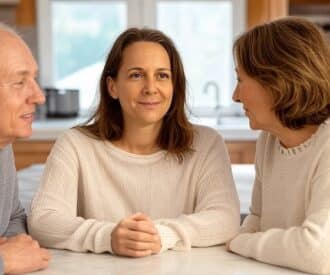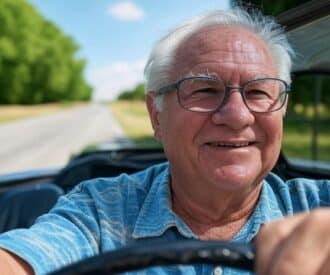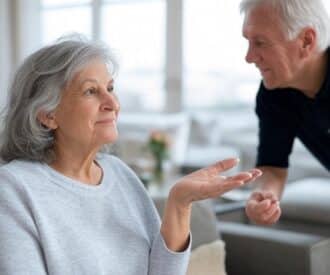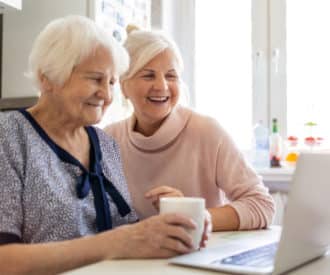
If your older adult has recently taken a fall, you’re probably worried about what to do next. TheKey (formerly, Home Care Assistance) shares 5 steps to take to reduce the chances that they’ll fall again.
Prevent additional senior falls with recovery tips
Every year, about 3 million older adults suffer a fall that’s bad enough to land them in the emergency room.
Falls caused more than 34,000 deaths in 2019 (the most recent statistics available), making it the leading cause of death by injury for people age 65 and older.
Despite these scary statistics, most people don’t think about fall prevention and recovery – until someone they love falls.
If an aging parent or another older adult in your life has recently taken a tumble, you’re probably anxious about what should happen next.
How do you make sure they are OK? What can you do to keep them living at home safely and prevent them from falling again?
While there aren’t any one-size-fits-all answers, there are several steps you can take to reduce your older adult’s chances of having another accident.
Consider these 5 steps for your post-fall action plan.
1. Get a medical exam to find the root cause of the fall
One out of five falls causes a serious injury, like a hip fracture or head injury.
While treating injuries is clearly the first priority, the next crucial move is to arrange a checkup with your older adult’s primary care doctor or a geriatrician, a physician who specializes in caring for older adults.
“The single most important thing to do when an older person falls is [to] determine the root cause,” says Michael Wasserman, MD, a geriatrician, past president of the California Association of Long-Term Care Medicine, and a member of TheKey’s Scientific Advisory Board.
In other words, you need to try to figure out why the person fell in order to prevent future falls.
A number of chronic medical conditions are associated with falls, including arthritis, Parkinson’s disease, diabetes, and neuropathy (nerve damage that typically causes numbness in the legs or feet).
Other factors, such as vision loss, inner-ear problems that can cause vertigo, and orthostatic hypotension (a condition in which a person’s blood pressure drops quickly when they stand) are also common, says Dr. Wasserman.
Anemia, thyroid problems, dehydration, and incontinence – which can lead to frequent, urgent trips to the bathroom – can be problematic, too.
And some older adults suffer from “frailty syndrome,” which refers to the loss of muscle, stamina, and overall fitness that can increase the risk of falling.
Oftentimes, several overlapping issues contribute to an older adult’s tendency to fall, and it’s important to identify as many as possible, Dr. Wasserman adds.
Your older adult’s doctor should give them a thorough physical, including a gait and balance assessment.
Alzheimer’s and other diseases that cause dementia may lead to gait changes or impact balance or motor skills.
The doctor should also evaluate your older adult’s cognitive skills by using an assessment tool such as the Mini-Mental Status Exam. (Assessment tests should always be done by a trained medical professional.)
2. Review medications for possible side effects
Whether or not a medication’s side effect, such as dizziness, directly caused your older adult’s fall, this is a good time to conduct what’s called “a comprehensive medication review” with the help of their primary care doctor or pharmacist.
Polypharmacy, which refers to taking multiple medications, is linked to mobility problems – and 23 percent of older adults take five or more meds per day.
Polypharmacy also increases the risk of adverse drug reactions, which, in turn, can lead to falls.
A comprehensive medication review, an in-depth, in-person or virtual meeting with a doctor or pharmacist, is designed to highlight medication side effects, catch potential drug interactions, and determine whether all the medications your older adult is taking are necessary and/or if dosages need to be adjusted.
Yet, very few older adults ever have such a review. Ask their doctor or pharmacist about scheduling a session for your older adult as soon as possible.
3. Encourage older adults to address their relevant health issues
The exact game plan for preventing falls will vary from person to person. However, here are some proactive steps to take now.
- Ask your older adult’s doctor about making changes to medications to reduce side effects such as dizziness, sleepiness, and sudden changes in blood pressure.
- Encourage your older adult to use a cane, walker, or other supportive aid.
- Have your older adult work with a physical or occupational therapist to improve their balance, muscle strength, and endurance.
- Make sure your older adult’s eyeglasses and hearing aid prescriptions are up to date.
- Consider getting your older adult an ankle-foot orthotic device. Also called an orthosis, the device is a brace designed to help maintain better balance and stabilize posture.
- Enroll your older adult in a local exercise program for seniors, such as tai chi or yoga, which emphasize balance. Research shows that older adults who exercise are less likely to fall.
- Sign your older adult up for a formal fall prevention program. Search online using the phrase “fall prevention program near me” to find a local program.
- Hire a home care aide, such as a senior companion, so that your older adult doesn’t have to take walks alone.
- Modify your older adult’s home with handrails or grab bars to make it easier to get around safely.
4. Hire a professional to conduct a home safety evaluation
An estimated six out of 10 falls happen in the home, which is why it’s wise to bring in an outside expert to do a thorough safety evaluation of the residence.
If you decide to do this type of assessment on your own, use a formal checklist – like this one – to guide you.
“The main things we’re looking for are whether there are enough handrails, adequate lighting, and whether there are throw rugs or loose cords that are easy to trip on,” says Beth Popolizio, PT, DPT, a training and development specialist for TheKey.
It’s also important to minimize clutter (especially on the floor and around stairs), use non-skid mats in the bathroom, and add grab bars where necessary, such as near toilets and showers.
And you might want to rearrange some furniture to make moving around the home easier.
Don’t hesitate to enlist help, as a team approach may be best.
Research from Johns Hopkins University found that bringing a nurse, occupational therapist, and handyman (to help install safety equipment, like grab bars) into the home resulted in an improvement in people’s functionality, notes Dr. Wasserman.
5. Help them move past the fear of falling
Falls are scary, and it’s natural to want to avoid having another.
The problem is that some older adults become so fearful of falling, that they end up moving less because of it.
“People can get stuck in a fear/avoidance cycle and start to limit their activity,” says Dr. Popolizio. “Over time, that degrades their strength, power, endurance, and functional independence, which increases their risk of subsequent falls.”
To break the fear-of-falling cycle, focus on building your older adult’s confidence and strength.
Signing them up for a supervised exercise program like tai chi or yoga for older adults, as mentioned above, can help as well as encouraging them to use assistive tools, such as canes and grab bars.
If the person is extremely fearful, a type of talk therapy called cognitive behavioral therapy (CBT) may help. Research has shown that CBT is effective in reducing the fear of falling and improving balance in older adults.
CBT teaches how to identify and reframe negative thoughts that would otherwise have a negative impact on behavior.
Ask their doctor for a recommendation or use the APA Psychologist Locator to search for a therapist near you (ideally one who focuses on aging).
Recommended for you:
- Prevent Falls with 5 Warning Signs of Mobility Issues in Seniors
- Prevent Falls in Seniors with This Helpful Conversation Guide
- 8 Things to Have the Doctor Check After an Aging Person Falls
Guest contributor: For over 20 years, TheKey (formerly, Home Care Assistance) has helped clients achieve successful long-term aging at home with comprehensive, concierge-based care. Ensuring the dignity, safety, and independence of our clients, we are committed to changing how the world lives and ages at home. Founded in Silicon Valley as a single location, we now offer service coverage throughout North America – enabling clients to live life on their own terms, in their own homes.
This article wasn’t sponsored and doesn’t contain affiliate links. For more information, see How We Make Money.
[optin-monster slug=”yxbytm35zhsdfopnw7qk”][optin-monster slug=”jvhyplxmb4umsjazxecn”]




